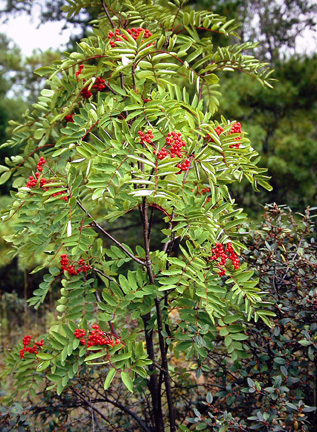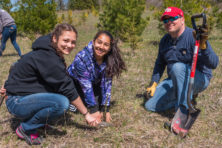Door to Nature: National Arbor Day
- Share
- Tweet
- Pin
- Share

I’m not sure what motivated my dad to be a tree planter and to enjoy trees so much, and perhaps he didn’t know either. But he still had a genuine love of trees to his 90th year of life.
There were three trees on the original home property in Kewaunee which he planted about 1935 that were especially beautiful and did extremely well in their growth. The small Mugo pine, a stunted and interesting tree of high mountainous regions of southern Europe, was one of my favorites.
A specimen that has become quite a landmark on the property is the ponderosa pine. What a beauty, a tree that does particularly well in this region even though it is a native of the West.
The other favorite of mine, native of Europe, is the Austrian pine that grew near the rock garden in the backyard. Judging by the hundreds of holes drilled into its bark by the yellow-bellied sapsuckers, we aren’t the only ones who liked the tree. Fortunately the birds’ excavating did not appear to be harming the tree in the slightest.
Tree planting has gone hand in hand with farming for around 150 years in the Midwest and the prairie states, making me feel that it is most likely Dad’s days on the farm near Slovan that helped him develop his interest in trees. He also planted quite a few there during the mid-1930s.
The passage of the Homestead Law in 1862 brought many settlers to the Great Plains and it didn’t take them long to realize that, due to the frequent strong winds, they needed to plant shelterbelts of trees. Either they had to control the soil-blowing and protect their crops or they failed miserably at farming.
In 1865 Kansas provided settlers with a tree bounty law to encourage more tree planting. Nebraska and the Dakota Territory passed tax-exemption laws in 1869 to also promote tree planting.
The Arbor Day concept originated in Nebraska and was first observed on April 10, 1872. It was J. Sterling Morton who proposed the idea at the time he was a member of the Nebraska State Board of Agriculture. Later Morton went on to become the third U.S. Secretary of Agriculture.
His son, Joy Morton, started the Morton Salt Company in 1885 and founded the famous Morton Arboretum in Lisle, Ill., in 1922. It is a nonprofit organization dedicated to planting trees and teaching about trees from all over the world.
A group that I support today is the Arbor Day Foundation, 100 Arbor Ave., Nebraska City, NE 68410. The main goal of this group is improved tree planting and tree care throughout North America. Their official website is arborday.org. They also manage the J. Sterling Morton Orchard and Tree Farm, which is a part of the estate of Arbor Day’s founder. The estate is also a National Historic Landmark.
Obviously trees interest people for different reasons. A logger will see board feet of lumber and “dollar signs” in a large mature oak tree while others would look at that same tree for its beauty, grandeur and shade, not to mention the red-tailed hawk that nests high among its top-most branches.
What may come as a surprise to many is the fact that roughly only one-third of the total timber harvested in this region ends up as lumber. More than one-third of the timber goes into the manufacture of paper and pressed board production. The remainder is used for fuel (10 percent), veneer logs (plywood), excelsior bolts, posts, cabin logs, railroad ties, mine timbers, poles and piling.
One can discover many facets of importance in the living woods including the tourist trade (they like woods and water), hunting wildlife that depends upon wooded areas, plantations of Christmas trees, making of maple syrup and the gathering of wild fruits, mushrooms and nuts.

The serviceberry also produces fruit and it is one of the smaller trees that have showy white blossoms in spring. Photo by Roy Lukes.
Charlotte and I look back with interest at the building of the 900-foot-long driveway through our woods in 1979. We had owned the property for two years before we could decide exactly where the winding “Jens Jensen” driveway would be built. We wanted to study the woods during the blossoming and growing season before tampering with it.
Shortly after starting to fell the trees by hand that had to be removed we came upon a tiny 15-inch-tall white pine directly in our path. It was easy to transplant it about 40 feet to the east of the route, and today it is nearly 50 feet tall and growing very well.
We learned, before building our home, that strong winter winds from the northwest drifted one section of the driveway, so we decided to plant 500 white spruces in that general area to serve as a windbreak. This has worked out perfectly, plus it is adding beauty and greenery to the winter landscape. The thickets are also providing wildlife shelter and nesting sites. A robin nested last spring in one of the spruces near the garden.
With Arbor Day to be celebrated on April 28th each year, there are many good selections of trees you can plant. Trees such as birch, black cherry, flowering crab, hackberry, hawthorn, mulberry, Norway spruce, pines, red cedar (not to be planted near apple orchards), serviceberry, oaks, mountain ash and maples are good to begin with. Excellent shrub choices to provide food and cover are elderberry, the dogwoods, arrowwood, huckleberry and highbush cranberry.
Start your wildlife habitat improvement program that will enrich your lives in many ways in addition to helping our dwindling wildlife not to mention the very air we are breathing. Get a little soil under your fingernails. Plant some trees and celebrate Arbor Day in style!

